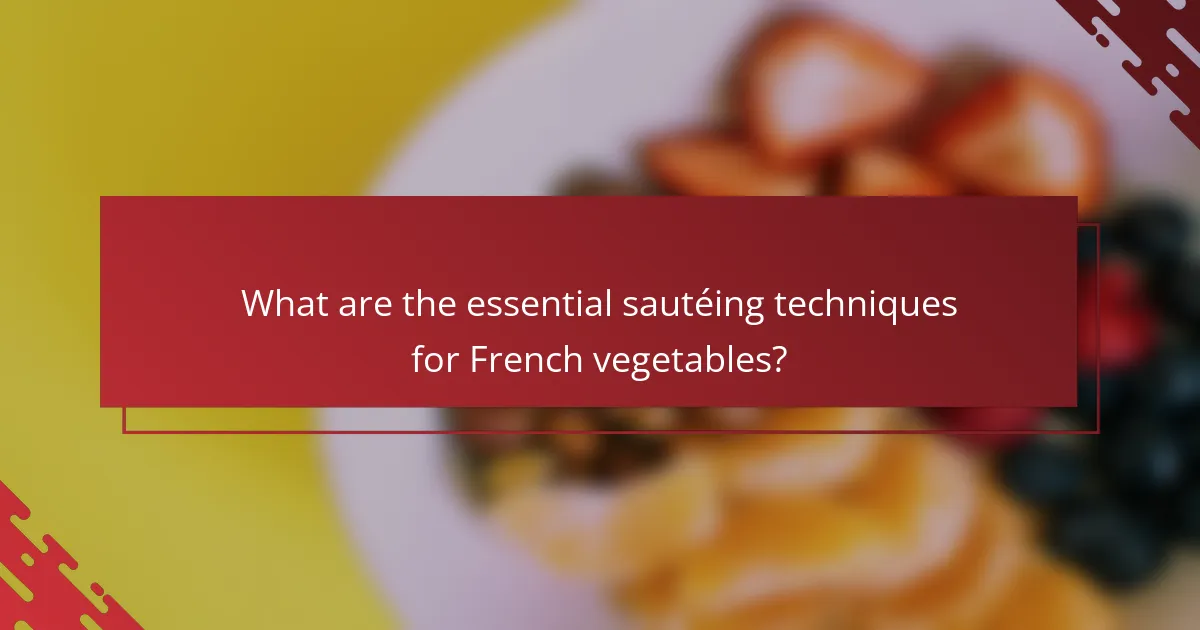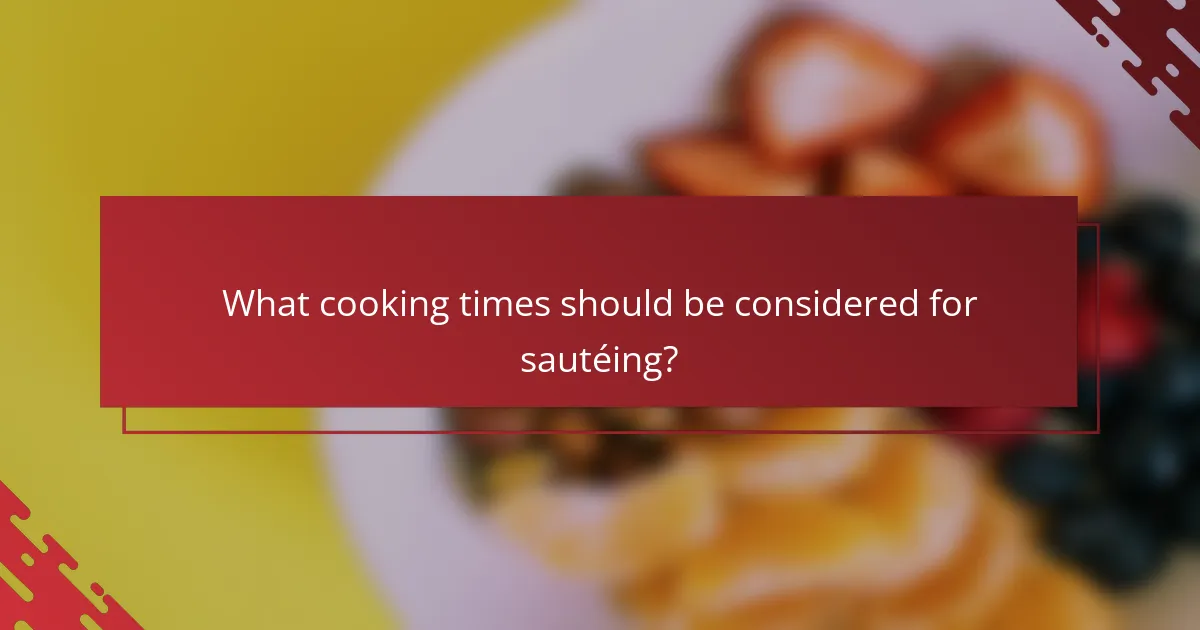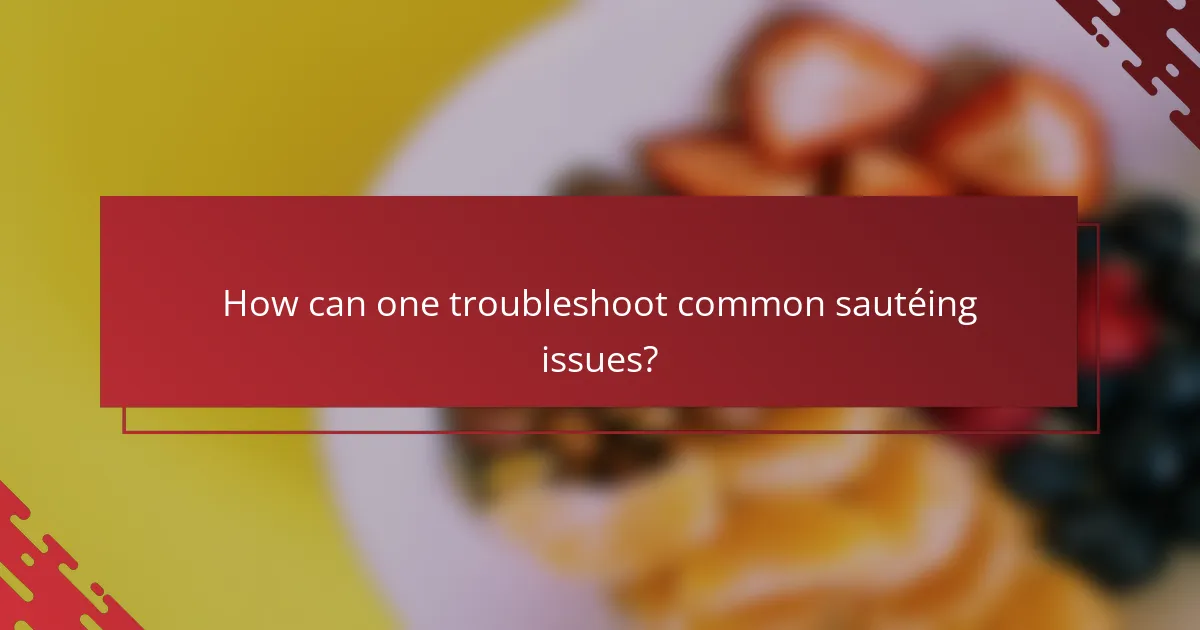Sautéing techniques for French vegetables focus on proper heat management, ingredient preparation, and timing to achieve optimal flavor and texture. Key methods include heating a pan to medium-high, using suitable oils like olive oil or butter, and cutting vegetables uniformly for even cooking. Cooking times vary based on vegetable type, with softer vegetables requiring 5 to 7 minutes and denser ones needing 10 to 15 minutes. Common sautéing issues such as sticking, burning, uneven cooking, and lack of flavor can be effectively addressed through specific troubleshooting strategies. Understanding these techniques is essential for mastering the art of sautéing in French cuisine.

What are the essential sautéing techniques for French vegetables?
Essential sautéing techniques for French vegetables include proper heat management, ingredient preparation, and timing. Start by heating a pan over medium-high heat until hot. Use a suitable oil, such as olive oil or butter, for flavor. Cut vegetables uniformly to ensure even cooking. Add vegetables in batches if necessary to avoid overcrowding. Stir frequently to promote even browning and prevent sticking. Adjust heat as needed to maintain cooking without burning. Cook until vegetables are tender but still crisp, typically 5 to 10 minutes, depending on the type. These techniques enhance flavor and texture, key elements in French cuisine.
How does sautéing differ from other cooking methods?
Sautéing is a cooking method that uses high heat and a small amount of fat. This technique differs from boiling, which submerges food in water. It also contrasts with steaming, where food cooks through vapor without direct contact with fat. Unlike baking, which uses dry heat in an oven, sautéing requires constant movement of food in a pan. Sautéing typically cooks food quickly, preserving texture and flavor. This method is ideal for vegetables, as it enhances their natural taste and color. High temperatures in sautéing allow for the Maillard reaction, which develops complex flavors.
What are the key characteristics of sautéing?
Sautéing is a cooking method that involves quickly frying food in a small amount of oil over high heat. This technique allows for the rapid cooking of ingredients while retaining their texture and flavor. Typically, sautéing is done in a shallow pan to maximize contact with the heat source. The food is often cut into small, uniform pieces to ensure even cooking. High heat helps to achieve a desirable browning effect, known as the Maillard reaction. This reaction enhances the flavor and aroma of the food. Sautéing is commonly used for vegetables, meats, and seafood. The process requires constant stirring or tossing to prevent sticking and ensure even cooking.
Why is sautéing preferred for French vegetables?
Sautéing is preferred for French vegetables due to its ability to enhance flavor and texture. This cooking method quickly cooks vegetables, preserving their natural taste and nutrients. Sautéing also allows for the development of a light browning, which adds depth to the flavor. The high heat used in sautéing helps to caramelize the sugars present in vegetables, creating a desirable taste profile. Additionally, sautéing requires minimal fat, making it a healthier cooking option. French culinary tradition emphasizes the importance of ingredient quality, and sautéing showcases the freshness of vegetables effectively. This technique is often used in classic French dishes, highlighting its significance in French cuisine.
What types of French vegetables are best suited for sautéing?
French vegetables best suited for sautéing include bell peppers, zucchini, and green beans. Bell peppers add sweetness and color when sautéed. Zucchini has a tender texture that cooks quickly. Green beans maintain a crispness while absorbing flavors. Other suitable vegetables are shallots, mushrooms, and leeks. Shallots provide a mild onion flavor. Mushrooms release moisture and enhance umami. Leeks offer a subtle sweetness. These vegetables cook evenly and complement various dishes.
Which seasonal vegetables enhance the sautéing experience?
Seasonal vegetables that enhance the sautéing experience include zucchini, bell peppers, asparagus, and green beans. Zucchini has a high water content, which helps create steam while cooking. Bell peppers add a sweet flavor and vibrant color to dishes. Asparagus provides a tender yet crisp texture when sautéed. Green beans maintain their crunch and absorb flavors well during cooking. These vegetables are typically at their peak freshness in spring and summer, making them ideal for sautéing. Their unique attributes contribute to a flavorful and visually appealing dish.
How do different vegetable textures affect sautéing time?
Different vegetable textures significantly affect sautéing time. Softer vegetables, like zucchini, cook faster due to their high water content. They typically require about 3 to 5 minutes of sautéing. In contrast, firmer vegetables, such as carrots and potatoes, take longer to soften. These can require 7 to 10 minutes of sautéing to achieve desired tenderness.
The density of vegetables also plays a role. Denser vegetables need more time to heat through. For instance, bell peppers sauté in around 5 to 7 minutes, while broccoli may take 6 to 8 minutes.
Cooking methods can also influence sautéing times. Cutting vegetables into smaller pieces can reduce cooking time. Uniformly sized pieces ensure even cooking, affecting overall sautéing duration.
What are the best oils for sautéing French vegetables?
The best oils for sautéing French vegetables are olive oil, canola oil, and grapeseed oil. Olive oil is favored for its flavor and health benefits. It has a smoke point of around 375°F, suitable for sautéing. Canola oil is neutral in taste and has a higher smoke point of about 400°F. This makes it versatile for various cooking methods. Grapeseed oil is also a good option due to its light flavor and high smoke point of approximately 420°F. These oils enhance the taste of French vegetables while providing a healthy cooking medium.
How does oil selection impact flavor and cooking temperature?
Oil selection significantly impacts both flavor and cooking temperature. Different oils possess unique flavor profiles that can enhance or alter the taste of sautéed vegetables. For instance, olive oil offers a fruity and peppery flavor, while sesame oil provides a nutty essence. The smoke point of an oil determines its maximum cooking temperature. Oils like avocado oil have a high smoke point of around 520°F, making them suitable for high-heat cooking. In contrast, oils with lower smoke points, such as extra virgin olive oil (approximately 375°F), are better for lower heat applications. Using the appropriate oil ensures that the flavors are preserved and the cooking process remains safe.
What are the smoke points of common sautéing oils?
The smoke points of common sautéing oils vary significantly. Olive oil has a smoke point of approximately 375°F (190°C). Canola oil has a higher smoke point at around 400°F (204°C). Grapeseed oil reaches about 420°F (216°C). Avocado oil boasts one of the highest smoke points, around 520°F (271°C). Peanut oil also has a high smoke point, approximately 450°F (232°C). Coconut oil has a lower smoke point of about 350°F (177°C). These values are crucial for selecting the right oil for sautéing to prevent burning and maintain flavor.

What cooking times should be considered for sautéing?
Sautéing typically requires cooking times of 5 to 15 minutes. The exact time depends on the type of vegetable and desired tenderness. Softer vegetables, like bell peppers, may take around 5 to 7 minutes. Denser vegetables, such as carrots, often require 10 to 15 minutes. Cooking at medium to high heat ensures even cooking and browning. Stirring frequently prevents sticking and promotes uniform doneness. Using a suitable amount of oil can also influence cooking time. Proper sautéing enhances flavor and texture, making it an essential technique in French cooking.
How do cooking times vary for different types of French vegetables?
Cooking times for different types of French vegetables vary significantly. For example, green beans typically require 5 to 7 minutes to sauté until tender. Carrots, when sliced thin, take about 7 to 10 minutes. Zucchini cooks faster, needing only 3 to 5 minutes. Bell peppers usually take around 5 to 8 minutes to soften. Eggplant may require 10 to 12 minutes for proper cooking. These times depend on the size and cut of the vegetables. Cooking methods, such as sautéing, also influence the duration. Understanding these variations ensures optimal texture and flavor in dishes.
What factors influence cooking time during sautéing?
Cooking time during sautéing is influenced by several factors. The type of vegetable affects cooking time due to varying water content and density. For instance, denser vegetables like carrots take longer to cook than softer ones like zucchini. The size of the vegetable pieces also plays a role; smaller pieces cook faster than larger ones. The heat level of the stove impacts cooking time; higher heat results in quicker cooking. The amount of oil used can affect heat distribution and cooking speed. Additionally, the type of pan influences heat retention and distribution, with materials like cast iron retaining heat better than non-stick pans. Finally, the presence of moisture in the pan can slow down the cooking process, as it creates steam.
How can you determine when vegetables are perfectly sautéed?
Vegetables are perfectly sautéed when they are tender yet crisp, with a golden-brown exterior. This texture indicates that the sugars in the vegetables caramelize properly. Visual cues include a slight browning on the edges and a vibrant color. The vegetables should also emit a fragrant aroma. Cooking time varies based on the type and size of the vegetables. For example, thinly sliced bell peppers may take 5-7 minutes, while thicker pieces of zucchini may require 8-10 minutes. Taste testing during cooking can also help determine doneness. Perfectly sautéed vegetables retain their nutrients and flavor, enhancing the overall dish.
What techniques can enhance sautéing efficiency and flavor?
Using high heat and preheating the pan enhances sautéing efficiency and flavor. This technique promotes quick cooking and caramelization. Choosing the right oil, such as olive oil or clarified butter, can also improve flavor. These oils have higher smoke points, allowing for better heat retention. Cutting vegetables uniformly ensures even cooking and prevents some pieces from burning. Stirring frequently distributes heat and flavors evenly. Adding aromatics like garlic or herbs at the right time boosts flavor without burning them. Finally, cooking in batches prevents overcrowding, which can lead to steaming instead of sautéing. These techniques collectively contribute to a more efficient and flavorful sautéing process.
How does cutting technique affect cooking time and flavor?
Cutting technique significantly affects both cooking time and flavor. Smaller cuts increase surface area, leading to faster cooking. For instance, diced vegetables cook quicker than larger chunks. This is due to heat [censured] being more efficient in smaller pieces. Additionally, the way vegetables are cut can influence their flavor release. Slicing onions, for example, can enhance their sweetness by promoting caramelization. Uniform cuts ensure even cooking, preventing some pieces from being overcooked while others remain raw. Research shows that cutting techniques can alter the texture and taste of food, impacting overall dish quality.
What role does seasoning play in the sautéing process?
Seasoning enhances the flavor of ingredients during the sautéing process. It allows the natural tastes of vegetables to shine through. Proper seasoning balances the dish and can elevate its overall profile. Salt is a common seasoning that helps draw out moisture from vegetables. This moisture release aids in achieving a desirable texture. Additionally, herbs and spices can add depth and complexity to the dish. Seasoning should be adjusted throughout cooking for optimal flavor development. A well-seasoned sautéed dish can significantly improve the dining experience.

How can one troubleshoot common sautéing issues?
To troubleshoot common sautéing issues, first identify the problem. If food sticks to the pan, ensure the pan is adequately preheated and use enough oil. If food is burning, lower the heat and stir more frequently. For uneven cooking, cut ingredients into uniform sizes. If vegetables are soggy, avoid overcrowding the pan and increase heat to promote evaporation. If flavor is lacking, season food properly during sautéing. These solutions address typical sautéing problems effectively.
What are common problems faced when sautéing vegetables?
Common problems faced when sautéing vegetables include uneven cooking and burning. Uneven cooking occurs when vegetables are cut into inconsistent sizes. This leads to some pieces being undercooked while others are overcooked. Burning happens when the heat is too high or when vegetables are left unattended. Overcrowding the pan can also trap steam and prevent proper browning. Using insufficient oil can cause sticking, making it difficult to achieve a good texture. Additionally, not preheating the pan can result in poor searing. These issues can compromise the flavor and texture of the final dish.
How can overcooked vegetables be avoided during sautéing?
To avoid overcooked vegetables during sautéing, control the cooking time and temperature. Use high heat to quickly cook vegetables while retaining their texture. Cut vegetables into uniform sizes for even cooking. Stir frequently to prevent sticking and ensure even exposure to heat. Add vegetables in batches if necessary to avoid overcrowding the pan. Monitor the cooking process closely, removing them from heat as soon as they are tender-crisp. This technique preserves their color and nutrients. Cooking times vary by vegetable type; for example, bell peppers may take 3-5 minutes, while zucchini can take about 2-3 minutes.
What should you do if vegetables stick to the pan?
To prevent vegetables from sticking to the pan, use enough oil during cooking. A well-heated pan also helps create a non-stick surface. If vegetables are already stuck, try adding a splash of water or broth. This can help release the food from the surface. Gently scrape the stuck bits with a wooden spatula. This method minimizes damage to the pan. Additionally, consider using non-stick cookware for easier cooking. Properly seasoning the pan can also improve its non-stick properties.
What are some best practices for successful sautéing of French vegetables?
Successful sautéing of French vegetables requires high heat and the right oil. Use oils with high smoke points, such as canola or grapeseed oil. Preheat the pan before adding the oil to ensure even cooking. Cut vegetables uniformly for consistent cooking times. Add vegetables in batches to avoid overcrowding the pan. Stir frequently to promote even browning and prevent burning. Season with salt and herbs to enhance flavor. Monitor cooking times; softer vegetables cook faster than firmer ones. These practices yield vibrant, flavorful sautéed vegetables.
How can preparation techniques improve sautéing outcomes?
Preparation techniques can significantly enhance sautéing outcomes. Properly cutting vegetables into uniform sizes ensures even cooking. This consistency allows for better heat distribution, preventing some pieces from burning while others remain undercooked. Additionally, drying vegetables before sautéing removes excess moisture. This step promotes better browning and caramelization, key components of flavor development. Using the right oil with a high smoke point, such as canola or grapeseed, prevents burning and enhances flavor. Pre-heating the pan adequately ensures that vegetables start cooking immediately upon contact, further improving texture and taste. These techniques collectively contribute to a more successful sautéing process, resulting in flavorful and well-cooked dishes.
What tips can help achieve a perfect sauté every time?
To achieve a perfect sauté every time, ensure your pan is preheated before adding ingredients. A hot pan allows for proper browning and prevents sticking. Use the right type of oil with a high smoke point, such as canola or grapeseed oil. This helps prevent burning and enhances flavor. Cut vegetables into uniform sizes for even cooking. This ensures that all pieces cook at the same rate. Avoid overcrowding the pan, as this lowers the temperature and causes steaming instead of sautéing. Stir frequently to promote even cooking and prevent burning. Finally, season your ingredients at the right time; adding salt too early can draw out moisture and lead to sogginess. These tips are supported by culinary experts who emphasize the importance of temperature, oil choice, and ingredient preparation for successful sautéing.
The main entity of the article is sautéing techniques for French vegetables, which encompasses methods, oils, and cooking times. The article provides essential techniques for sautéing, including heat management, ingredient preparation, and timing to achieve optimal flavor and texture. It discusses the differences between sautéing and other cooking methods, the best types of oils for sautéing, and the impact of vegetable textures on cooking times. Additionally, it outlines common sautéing issues and best practices for successful outcomes, ensuring that readers can effectively enhance their culinary skills in preparing French vegetables.